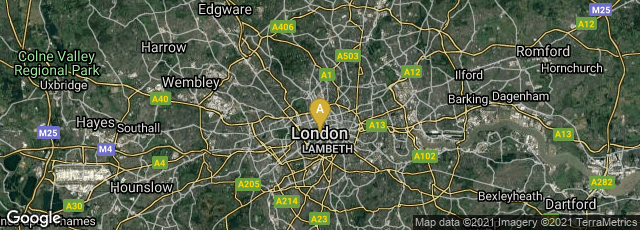

A: London, England, United Kingdom
In 1822, roughly two decades before we have evidence of the existence of functional typesetting machines, such as those built by Young & Delcambre, American physician, inventor and civil engineer living in England William Church received British patent no. 4664 for "An Improved Apparatus for Printing." This patent, which was illustrated with 8 large folding engineering drawings, consisted of three parts: "first, a machine for casting the printing types, and also of arranging them in boxes of letters, so that the types of the same denomination are placed side by side in ranges, ready to be transferred to the composing machinery. The second part of the apparatus consists of a machine, by which the individual types are selected and composed into words and sentences. The third part of the apparatus is a press for printing and delivering the sheets into a pile" (Church's patent p. 2).
The first patented machine for type composition, Church's invention may never have actually been built, and is known almost entirely from his patent, which showed a "rapid" typecasting machine, a mechanical typesetter, and a newly designed bed-and-platen printing machine, in that order. These three devices comprised a system which was decades later followed by letterpress printers, with the basic gravity-driven principle of Church's typesetting machine followed by later inventors such Young & Delcambre, Rosenborg, and others. That Church's machine was well known in England at the time the patent was issued is confirmed by the long, critical and almost incredulous discussion of it by Thomas Hansard in his Typographia, an Historical Sketch of the Origin and Progress of the Art of Printing (1825) pp. 665-677 where he discusses "The Printing Machines and other Inventions relative to Printing of Doctor William Church."
"While there is no evidence that a composing machine was built, the design included features which were embodied in later inventions. The type was stored in inclined channels, from which it was relased by the operation of a keyboard. The released type fell into a horizontal race where it was assembled by rocking arms into a continous line. Like other early composing machines, Church's did not provide for justification of the lines, leaving that to be done by hand. Power was provided by a clock-work mechanism" (Printing and the Mind of Man. Catalogue of an Exhibition at Earl's Court, London, 16-27 July 1963 [1963] No. 462).
Huss, Dr. Church's "Hoax": An Assessment of Dr. William Church's Typographical Inventions in which is Enunciated Church's Law (1976).